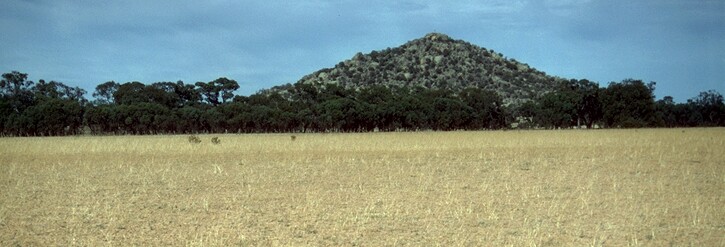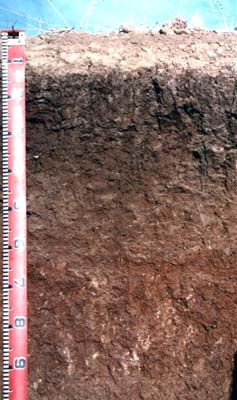LP47
| Property: LP47 | Australian Soil Classification: Vertic (and Calcic), Subnatric, Red SODOSOL |
| Northcote Factual Key:Dr 2.13 | Great Soil Group: red-brown earth |
| General Landscape Description: Level alluvial plain near Pyramid Hill. | |
 LP47 Landscape |
Soil Profile Morphology
Surface Soil
| A11 | 0-5 cm | Strong brown (7.5YR5/6); silty clay loam; surface flake; structureless; very firm consistence dry; pH 6.0; abrupt and wavy change to: |  LP47 Profile |
| A12 | 5-10 cm | Strong brown (7.5YR4/6); silty clay loam; structureless, strong consistence dry, pH 6.3; sharp and wavy change to: | |
| Subsoil | |||
| B21 | 10-35 cm | Reddish brown (5YR4/4); medium clay; moderate coarse prismatic, parting to strong blocky structure; very firm consistence dry; pH 7.8; clear and wavy change to: | |
| B22 | 35-50 cm | Yellowish red (5YR5/8); light medium clay; moderate coarse polyhedral structure, slickensides evident; firm consistence moist; pH 8.5; gradual change to: | |
| B23 | 50-90 cm | Yellowish red (5YR5/6); medium clay; strong medium polyhedral structure; firm consistence moist; contains a few (2-10%) fine-earth carbonates and gypsum crystals (5%) in pockets; pH 7.8; gradual change to: | |
| B3 | 90+ cm | Pale brown (10YR6/3); light medium clay; strong medium polyhedral structure; firm consistence moist; contains very few (2%) coarse calcareous nodules (with silica); pH 8.5. | |
Key Profile Features
- Strong texture contrast between surface A horizons and subsoil (B21) horizon.
- Slickensides present in the subsoil.
Key Profile Characteristics
pH | Salinity Rating | |||
Surface (A1 horizon) | moderately acid | low | non-sodic | none1 |
Subsoil (B21 horizon) | slightly alkaline | very low | sodic | moderate |
Deeper subsoil (90 cm) | moderately alkaline | very high | strongly sodic | none2 |
| 1 Slight dispersion after remoulding. 2 No dispersion due to high Total Soluble Salt content | ||||
 |
Horizon | Horizon Depth | pH (water) | EC 1:5 | NaCl | Exchangeable Cations | |||
Ca | Mg | K | Na | |||||
meq/100g | ||||||||
A11 | 0-5 | 6 | 0.47 | <0.05 | 4.7 | 1.8 | 0.6 | 0.1 |
A12 | 5-10 | 6.3 | 0.13 | 3.5 | 2.4 | 0.5 | 0.3 | |
B21 | 10-35 | 7.8 | 0.26 | 0.05 | 8.1 | 7.6 | 1 | 2.6 |
B22 | 35-50 | 8.5 | 0.63 | <0.05 | 7.6 | 8.9 | 0.8 | 4.3 |
B23 | 50-90 | 7.8 | 3.75 | 0.15 | 15 | 8.7 | 0.9 | 5.3 |
B3 | 90+ | 8.5 | 1.95 | 0.36 | 6.8 | 9.3 | 0.9 | 5.9 |
Horizon | Horizon Depth | Ex Al mg/kg | Ex Ac meq/100g | Field pF2.5 | Wilting Point pF4.2 | Coarse Sand (0.2-2.0mm) | Fine Sand (0.02-0.2mm) | Silt (0.002-0.02mm) | Clay (<0.002mm) |
A11 | 0-5 | 27.5 | 12 | 1 | 31 | 43 | 26 | ||
A12 | 5-10 | 23.3 | 13.2 | 1 | 27 | 43 | 29 | ||
B21 | 10-35 | 35.9 | 24.9 | 0.4 | 10 | 24 | 65 | ||
B22 | 35-50 | ||||||||
B23 | 50-90 | ||||||||
B3 | 90+ |
Management Considerations:
- In general, management strategies for all soils should aim to increase organic matter levels in the surface soil; minimise the degradation of soil aggregates and porosity; promote the development of stable biopores; improve the calcium status of the ion exchange complex (particularly when sodium is a significant part), and break up any hardpans. Less frequent tillage; using less aggressive implements, and working the soil at optimum moisture conditions can all assist in maintaining soil aggregation and porosity as well as reducing the breakdown of organic matter.
Surface (A) Horizons
- The surface (A) horizon has a high fine sand (31%) and silt (43%) content which will make it hardsetting when dry and liable to become "powdery" when cultivated, resulting in structural degradation. Subsequent rain may form a surface crust. Tillage should be minimised and stubble retention/pasture rotation practised to build up organic matter content.
- The surface horizon has a very low organic matter content and a low overall nutrient status. Improving surface soil organic matter will assist in minimising structural problems such as surface sealing and hardsetting as well as improving soil fertility and water holding capacity.
- The subsurface (A12) horizon disperses moderately after remoulding. This suggests that this horizon could develop into a hard compacted layer (ploughpan) if excessively cultivated in a wet condition. Gypsum is likely to be an effective ameliorant for soil such as these. A gypsum responsiveness test (assessed for the whole paddock) would be useful to assist in making decisions about gypsum application.
Subsoil (B) Horizons
- Medium to high soluble salts occur from a depth of 50 cm. This is likely to restrict the growth of salt-sensitive species. Below the 90 cm depth, the salinity rating has increased to very high.
- The coarsely structured upper subsoil (B21) is sodic and disperses in water. This is likely to result in restricted root and water movement into the subsoil.
- The subsoil will shrink and swell significantly on wetting and drying. This may have engineering implications (e.g. effect on foundations).
Landholder Comments:
- Gypsum applied last year - no response so far.
- Lupins and lucerne have been cropped here.
- Wheat has been planted.
- Never flooded.
Notes:
Soil profile described by Mark Imhof, Paul Rampant and Karen de Plater (1/3/95)


